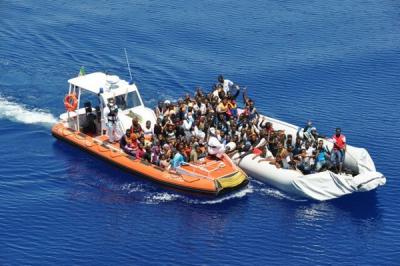Ten migrants claimed by the Mediterranean

ROME – Another rescue mission to save 223 migrants from a watery grave was mobilised on Thursday but were too late to save the lives of 10 women, whose bodies were later pulled from the water, the Ministry of Infrastructure and Transport (MIT), confirmed.
A rubber dingy off the coast of Lybia was rapidly taking on water Thursday morning as migrants made vain efforts to stop the boat sinking. Italian rescue services, mobilised by the country's Coast Guard Operation Centre in Rome, managed to rescue 107 migrants from the wreck. Barely hours later, another rescue mission was called on to salvage a further 116 immigrants from a nearby position off the North African coast, hoping to make the crossing into Europe.
This comes in addition to the rescue operations that took place on Wednesday, saving as many as 1288 migrants in six different missions. Five of the rescues, which were carried out in the Sicilian Canal, were particularly difficult to carry out given the adverse weather conditions and turbulent waters. The first rescue party, which brought around 430 migrants to safety from a fishing boat that had gone adrift in the Search and Rescue area came in at dawn on Wednesday, with four other rescue parties commissioned by the Coast Guard Service following shortly after.
The sixth rescue mission was carried out off the coast of Oltranto, where another 51 migrants were saved from an overloaded sailing boat that was coming in to trouble. The rapid response of the Italian Coast Guard service, with assistance from the Military Marina and the Migrant Offshore Aid Station (MOAS), facilitated the success of these rescue missions, but the increasing frequency of these extreme and dangerous shipwrecks is causing rapidly escalating concern for the coastal rescue teams.
This latest migrant rescue coincidentally ties in with the raising of the “ship of death” from the seabed just north of Libya. The fishing vessel, which sank in April 2015 85 miles north of the Libyan coast, has been considered one of “the deadliest shipwrecks in decades of seaborne migration from North Africa towards Europe” since it is thought to be the grave of over 700 people.
The shipwreck, from which there were only 28 survivors and a further 118 bodies found, is thought to contain vast numbers of migrants’ bodies, mainly those of women and children, who were “locked below decks”.
The particulars of the operation are to be confirmed on Thursday, but the general mission is for the ship and its contents to be brought to land to the port of Augusta, in Sicily, in a refrigerated structure, where rescuers will set to work retrieving bodies from the wreck and then experts will try to identify the victims. The Italian Ministry of Defence along with the prefecture of Syracuse, and other organisational bodies are collaborating to facilitate this project, which is deemed of the upmost importance as a means of providing a justice of sorts to those who died in this tragedy. There will be a 150-strong team of people on land working to get to the bottom of the disaster, among which will be Marines, fire-fighters and the Italian Red Cross, to make sure that the greatest level of clarity possible is achieved.
It was as a result of this tragedy of titanic proportions and the widespread public outrage that ensued, that the European Union were prompted to restore rescue operations in the Mediterranean; a decision, the importance of which we are reminded almost daily, with news of migrant shipwrecks, such as the six brought to safety on Wednesday.
dt


